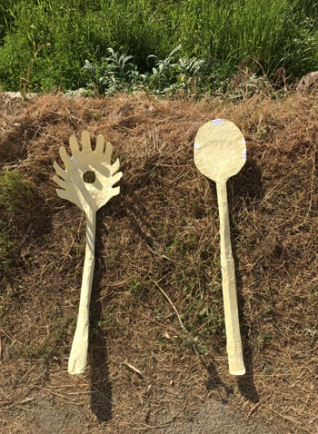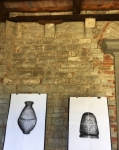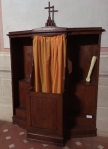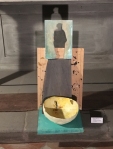Pieve di San Cresci of Domesticity, The Archeological Museum of Domesticity and the Everyday, Exhibition, 18th of May, 2018, Residency, La Macina di San Cresci, Italy
Artist Statement, Pieve di San Cresci of Domesticity

The installation, ‘Church of Domesticity, the Archeological Museum of Domesticity and the Everyday’, evolved from a two week residency at La Macina di San Cresci, Italy, in May 2018. The work explores the role of motherhood and at the same time a calling and occupation as an artist. Objects from the outer domestic sphere evoke limitations and demands of everyday life which are then placed within the inner celestial world of the church. The work is both a celebration and acknowledgemnet of the domestic, and a recognition of the desire for transcendence, the function of the church and of art.
- 1. Veil
- 2. To hold and to support
- 2. To hold
- 2. To support
- 3. Confessions of a working mother
- 4. Shrines to making art
- 4. Shrines to making art
- 5. Relics
- 5. Relics
- 5. Relics
- 6. Altar piece
- 6. Altar piece
- 7. Seven days of creation
- 7. Seven days of creation, a) the artist’s book
- 7. Seven days of creation, b) bowl
- 7. Seven days of creation, c) utensils
- 7. Seven days of creation, d) washing day
- 7. Seven days of creation, e) children
- 7. Seven days of creation, f) love and humility
- 7.Seven days of creation g) rest
- Pieve di San Cresci
List of works: Pieve Di San Cresci of Domesticity
- Veil
- To hold and to support
- Confessions of a working mother
- Shrines to the making of art
- Relics
- Altar piece
- Seven days of creation; 7a. the artist’s book, 7b. bowl, 7c. utensils, 7d. washing day, 7e. children, 7f. love and humility, 7g. rest

OBJECTS CREATED AT THE RESIDENCY:
Drawings on paper in situ
Sculptural paper assembledges
Paper mache constructions as well as cast forms from surrounding architectural features and an ancient road side stones. Paper mache bowl, road side mileage marker, pasta utensils, a symbol of labour, the iron bar to attach a horse to grind olives on the ancient olive oil press still existing in the studio today.
Painted firewood from the studio to create sculptural forms resulting in the cross and saints for the altar.
Reconstructed found objects using items in the studio left by previous residents: cardboard, perspex paint palettes, jars of paint samples, and candles from a local church, all commemorate the artist shrine, a homage to making, acknowledging the difficulty to transcend the everyday in order to create something of meaning.
The colour yellow. used throughout this installation holds significance historically in Italian art, representing remembrance of the spiritual world and sustenance of the soul, the colour appearing regularly in Medieval and Renaissance paintings. Yellow also indicates a source of water in the local architecture of the region, often a building painted in a strong yellow will indicate a pump station, appearing as a marker in the landscape. The egg yellow fabric in the installation symbolises transcendence as in the confession box, along with yellow pigment mixed with plaster added to papermache forms. In contrast some forms contain a fleshy pink within, historically repressing eternal innocence, conception and the Virgin and Child.















































